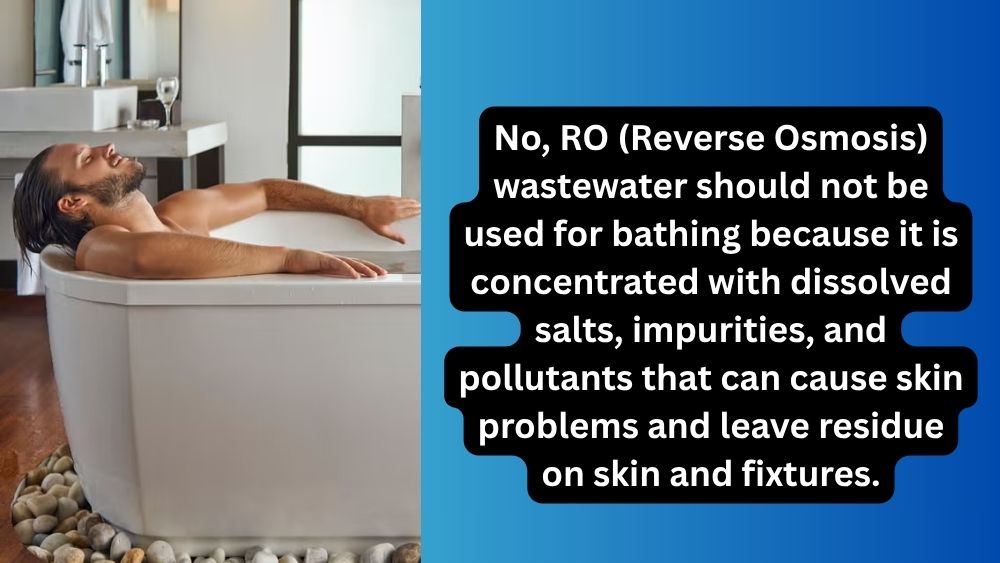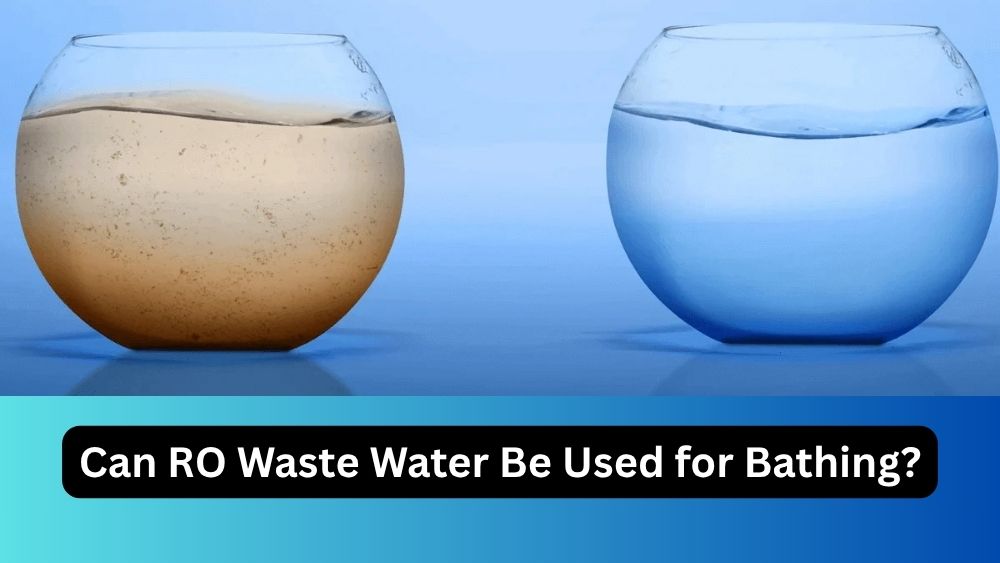Reverse osmosis (RO) systems provide some of the cleanest drinking water available, but they also produce a significant amount of reject water in the process. This reject water, often called RO waste water, raises a common question: can it be reused, and more specifically, can it be used for bathing?
The simple answer is yes, RO waste water can be used for bathing, but with certain precautions. While it is not safe for drinking, it is generally safe for external uses such as bathing, cleaning, and gardening when handled properly. In this article, we will explain the composition of RO reject water, the risks of using it for personal hygiene, and the most practical ways to reuse it effectively.
Why RO Systems Produce Waste Water
RO systems work by pushing water through a semi-permeable membrane that separates pure water from dissolved solids and contaminants. The clean water goes to your drinking line, while the rejected impurities are flushed out as waste water.
On average, older RO units may waste four to nine gallons of water for every one gallon of purified water. Modern systems are more efficient, wasting about two gallons per gallon of clean water. To learn why waste is unavoidable in this process, see why RO systems waste so much water.
Composition of RO Waste Water
RO waste water is not “dirty” in the sense of sewage, but it does contain a higher concentration of the salts, minerals, and contaminants that the RO membrane rejects.
- Total dissolved solids (TDS): Usually higher than in the source water.
- Hardness: Contains more calcium and magnesium.
- Salts and chlorides: Concentrated compared to purified water.
- Trace chemicals: May include fluoride, nitrates, or metals, depending on your source water.
While not toxic to touch, the elevated mineral content can sometimes cause dryness or mild irritation on sensitive skin.
Is It Safe to Use RO Waste Water for Bathing
Yes, in most cases, RO waste water is safe to use for bathing, especially if your source water was already municipal tap water. Since the reject water is basically tap water with slightly higher concentrations of dissolved solids, it does not contain pathogens that are typically dangerous through skin contact.
However, caution is needed:
- People with very sensitive skin, eczema, or psoriasis may feel irritation due to high TDS.
- Harder water can leave a film on the skin or make soap less effective.
- Infants and those with open wounds should avoid bathing in RO reject water.
For general household use, it is similar to using moderately hard tap water, which is common in many cities. For more background on TDS in water, see what is TDS in water and why should you measure it.

Best Practices for Bathing with RO Waste Water
To make the best use of reject water without side effects, follow these guidelines:
- Mix waste water with fresh tap water to reduce TDS concentration.
- Use for short baths or showers rather than long soaks.
- Avoid if your local water supply has high levels of harmful contaminants such as arsenic. See how RO systems remove arsenic from drinking water.
- Always ensure storage tanks for reject water are clean to prevent bacterial growth.
Benefits of Using RO Waste Water
- Reduces water wastage: Every gallon reused saves fresh water.
- Cost savings: Lowers your water bill by reusing water that would otherwise go down the drain.
- Practical utility: Useful for non-drinking purposes like floor cleaning, flushing toilets, gardening, and yes, bathing.
- Environmentally responsible: Helps conserve resources in areas facing water scarcity.
Alternative Uses of RO Waste Water
Bathing is just one possible use. RO waste water can also be used for:
- Toilet flushing: One of the easiest and most efficient uses.
- Cleaning floors: Effective since high TDS does not matter much here.
- Gardening: Suitable for some plants, especially salt-tolerant varieties.
- Washing vehicles: Works well but may leave water spots due to hardness.
- Laundry pre-wash: For rinsing heavily soiled clothes before main wash.
For creative reuse ideas, see how to reuse waste water.
Table: Pros and Cons of Using RO Waste Water for Bathing
| Pros | Cons |
|---|---|
| Saves water and reduces waste | May irritate sensitive skin |
| Cost-effective reuse method | Hard water film on skin and hair |
| Similar to bathing in hard tap water | Not suitable for infants or wounds |
| Environmentally friendly | Soap lather may reduce effectiveness |
Expert Insights
According to water quality specialists, the main concern with using RO reject water for bathing is hardness. Hard water does not pose major health risks but may affect skin and hair texture. Dermatologists agree that occasional use is unlikely to cause harm for most people, but those with pre-existing skin conditions should stick to softened or purified water.
The EPA notes that hard water is generally safe for external use but can cause scaling and dryness over time (EPA.gov). Similarly, the World Health Organization acknowledges that hardness is not a health hazard but a nuisance factor (WHO.int).
Environmental and Cost Considerations
RO systems waste water as part of their purification process, but reusing that water for bathing and cleaning helps offset environmental costs. It also reduces the burden on municipal supply, especially in areas facing water shortages. For a detailed breakdown of efficiency, see how to reduce the operating cost of RO systems.
FAQs
1. Is RO waste water safe for bathing every day?
Yes, most people can bathe daily with RO waste water without problems. However, if you notice skin dryness or irritation, dilute it with fresh water.
2. Can children use RO reject water for bathing?
It is better to avoid using it for infants and young children, as their skin is more sensitive. For older children, diluted use is usually safe.
3. Will bathing in RO waste water harm my skin?
Generally no, but the higher mineral content can leave a film or cause mild dryness. Moisturizing after bathing helps reduce these effects.
4. Is RO waste water better than hard tap water for bathing?
They are similar, as both have higher TDS. If your tap water is already hard, RO waste water will feel much the same.
5. What is the safest way to reuse RO waste water at home?
The best uses are bathing, toilet flushing, cleaning floors, and gardening. Always ensure proper storage and avoid using it for drinking or cooking.
Conclusion
RO systems waste a considerable amount of water, but with smart reuse, that water can serve important purposes. Bathing with RO waste water is safe for most people as long as it is managed properly. The main concern is hardness, which may cause mild dryness or irritation for sensitive individuals.
By reusing reject water for bathing and other household chores, you conserve resources, save money, and reduce environmental impact. With simple precautions, you can turn what is often seen as waste into a valuable household resource. For more ideas, see how to reuse waste water and why RO systems waste so much water.

Hasan Al Sarker is a Reverse Osmosis Specialist. He has worked for many years to ensure safe drinking water for all. His research paper has been published in several journals, including Issue, Medium, and Slideshare. He is recognized as a water doctor among specialists though he did not attend medical college.
Besides working as a researcher of reverse osmosis technology, he is also very fancy with the kitchen and cooking. His guides are reading thousands of people every day. As a head of content, he is responsible for all the published articles at RO System Reviews.

